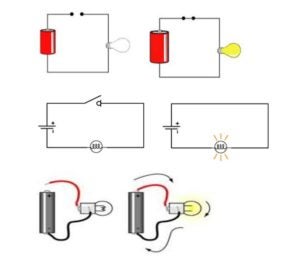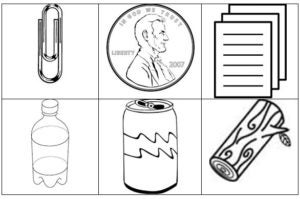Author: Melissa McPhillips
School/Organization:
Shawmont Elementary School
Year: 2015
Seminar: Electronics from Toys to Tools: An Adventure for Future Engineers
Grade Level: 1
Keywords: electricity, energy, nonfiction text, primary
School Subject(s): Science
The Common Core State Standards have had several impacts on education. One of the impacts is the focus on informational text being part of the curriculum from the very beginning. Throughout this unit I will use informational text to teach students that electricity carries energy. Students will also learn the difference between an open and closed circuit and that energy flows in a closed circuit. Students will then sort various objects as good conductors and insulators of electricity. As students learn how electricity carries energy they will be building upon their reading and writing skills. As a final project students will create a circuit in order to make a light bulb light.
Download Unit: McPhillips-Melissa-unit.pdf
Did you try this unit in your classroom? Give us your feedback here.
When students are reading about the world around them and are given opportunities to demonstrate their expertise on these topics through writing they appear to be highly engaged (Duke, 2013). Throughout this unit I will follow Nell K. Duke’s seven things that should be seen in a primary classroom effectively using informational text as I teach students about electricity. Duke begins by stating that the most effective thing to help students learn to read and write with informational text is to use informational text from the beginning. As this unit is intended for first grade students and could be adapted for a kindergarten classroom, using informational text to teach about electricity will be incorporating informational text from the beginning. Finding text that beginning readers can read independently and comprehend will have limited content. In order to increase students’ content knowledge of informational text read-alouds combined with engaging instructional activities should be presented (Duke, 2013). Some examples of read-aloud informational text that will be included in this unit are Switch On, Switch Off by Melvin Berger, What is Electricity? by Lisa Trumbauer, My Light by Molly Bang, and Science Everywhere! Electricity by Clint Twist. In addition to the read-aloud text, students should be provided with sets of related text. A sufficient number of informational texts on a single topic should be available for readers across the grade level (Duke, 2013). These texts should be acquired by the teacher prior to teaching the topic. Having various texts on a single topic available help to meet Common Core State Standards such as the standard that states “identify basic similarities in and differences between two texts on the same topic” (Duke, 2013). In addition to the read-aloud text, some additional related text I will use throughout this unit are Charged Up: The Story of Electricity by Jacqui Bailey and Matthew Lilly, Oscar and the Bird: A Book About Electricity by Geoff Waring, You Wouldn’t Want to Live Without Electricity by Ian Graham, and The Boy Who Harnessed the Wind by William Kamkwamba. As well as having a variety of text available for students to read and reference throughout the unit, the entire classroom environment should be an informational-text-rich environment (Duke, 2013). This can include posters around the room, articles hanging in places that are visited often by students, and also students own work that has been created on the topic should be posted around the room. The graphic organizers and work the students complete throughout this unit should be posted around at student eye levels. Informational text often includes many unfamiliar words to younger readers (Duke, 2013). Throughout this unit students will be coached to ask and answer questions about unknown words in order to meet Common Core State Standards. There will be several key vocabulary words that students will need to investigate, understand, and demonstrate. Some of the key vocabulary words include electricity, current, circuit, opened, closed, insulators, and conductors. These vocabulary words and their definitions will be displayed on sentence strips on a classroom bulletin board for student reference throughout the unit. Throughout the process of including informational text in read-alouds, as related text, and in creating an informational-text-rich environment student should also be taught about the text itself. In Grade 1, in which this lesson is intended, the focus should be on headings, table of contents, glossaries, electronic menus, and icons (Duke, 2013). Students can enrich and demonstrate their understanding of informational text by creating their own informational text with these features. Finally, an opportunity to share information through writing is a very important part of the Common Core State Standards. Throughout the lessons there will be opportunities as a whole group and as an extension activity for students to share information that have learned through their writing. These writing activities will also be posted throughout the classroom to increase our nonfiction print enriched classroom.
This unit is intended for students in 1st grade. The students spend most of their day in a self-contained classroom. They only leave for a 45 minute lunch period and a 45 minute prep class. The Objectives of this unit will include the following:
Think-Pair-Share Think-Pair-Share is another strategy that will be used. During Think-Pair-Share students will think in their head for several minutes about a question or idea, and then they will turn to the person next to them and share their thoughts. Think-Pair-Share allows for an increase in the quality of student responses. It gives students time to think and respond to questions or prompts. It also relieves the pressure off of students who may be intimidated to respond in front of the whole group. As students are discussing their responses they are also talking out their answers and are able to make better sense of their ideas. Activating Prior Knowledge The teacher will activate prior knowledge through each lesson. Through activating prior knowledge teachers are helping children to connect the text to what they already know. Activating prior knowledge helps students to begin to make connections to the new text they will be reading. When students are able to make connections to text they become more invested in the text they are reading or listening to. KWL Chart A KWL chart is a graphic organizer that can be used in any subject area. The K stands for what the students already know. The W stands for what the students want to know about the subject. Finally, L is for what the students learn about the subject. The KWL follows the students throughout an entire unit or theme. Graphic Organizers Students will use graphic organizers throughout this unit. Graphic organizers are a tool that allows students to visually express ideas and concepts. When students use graphic organizers they are able to see undiscovered patterns and relationships that they may not have seen by simply reading or listening to a story. Graphic organizers also help to facilitate conversation about the story and make an excellent reference. Modeling Modeling will be used by the teacher to help convey understanding of new ideas and methods. Modeling is when the teacher demonstrates how to complete different activities by saying aloud the thought process.
Lesson 1: What Do We Need Electricity For? (Building Background Knowledge) Objectives: Materials: Procedure: Extension: As an extension either in the classroom or for homework have the students write about one thing that uses electricity and they must use the word electricity in the sentence. Lesson 2: What is a Circuit? Open vs. Closed Objectives: Materials: Procedure: Extension: As an extension, either in the classroom or for homework, have the students illustrate their own open and closed circuits. Lesson 3: Insulators vs. Conductors Objectives: Materials: Procedure: Extension: As an extension, either in the classroom or for homework, have the students create a chart of conductors and insulators they see in the classroom or at their home. Lesson 4: Light it Up! Objectives: Materials: Procedure: Extension: Students who complete their circuit, make the light bulb light, and complete the hand out Light it Up! allow to experiment with the various insulators and conductors to see what will still allow the current to travel through and what will not.
Bibliography: Duke, N. (2013) “Starting Practices.” Educational Leadership November, 40-44. Print. Batteries. (n.d.). In Merriam-Webster’s online dictionary. Retrieved from http://www.merriam-webster.com/dictionary/battery. Cable. (n.d.). In Merriam-Webster’s online dictionary. Retrieved from http://www.merriam-webster.com/dictionary/cable. Circuit. (n.d.). In Merriam-Webster’s online dictionary. Retrieved from http://www.merriam-webster.com/dictionary/circuit. Conductor. (n.d.). In Merriam-Webster’s online dictionary. Retrieved from http://www.merriam-webster.com/dictionary/conductor. Energy. (n.d.). In Merriam-Webster’s online dictionary. Retrieved from http://www.merriam-webster.com/dictionary/energy. Electricity. (n.d.). In Merriam-Webster’s online dictionary. Retrieved from http://www.merriam-webster.com/dictionary/electricity. Insulator. (n.d.). In Merriam-Webster’s online dictionary. Retrieved from http://www.merriam-webster.com/dictionary/insulator. Lightning. (n.d.). In Merriam-Webster’s online dictionary. Retrieved from http://www.merriam-webster.com/dictionary/lighning. Teacher Resources: Janes, P (2004). “Zap! How Electricity Works.” Instructor, 113(7), 46-48. Marzano, R. (2009). The art and science of teaching/six steps to better vocabulary instruction. Educational Leadership, 67(1), 83-84. Ness, M. (2013) “Unpark Those Questions.” Educational Leadership November, 74-76. Trundle, K. (2010). Teaching Science During the Early Childhood Years. National Geographic Science, 8-10. Student Resources: Bailey, J., & Lilly, M. (2004). Charged up: The story of electricity. Minneapolis, Minn.: Picture Window Books. Bang, M. (2004). My light. New York: Blue Sky Press. Berger, M., & Croll, C. (1989). Switch on, switch off. New York: Crowell. Cole, J. & Degen, B. (1997). The magic school bus and the electric field trip. New York: Scholastic Press. Graham, I., & Walker, R. (n.d.). You wouldn’t want to live without electricity! Kamkwamba, W., & Mealer, B. (2009). The boy who harnessed the wind: Creating currents of electricity and hope. New York, NY: William Morrow. Trumbauer, L. (2003). What is electricity? New York: Children’s Press. Twist, C. (2006). Electricity. New York: Bearport Pub. Waring, G. (2009). Oscar and the bird: A book about electricity. Cambridge, Mass.: Candlewick Press.
Name: ____________________________ It’s Electric! Directions: Find as many items as you can of items that use electricity and glue them on the page below. Appendix B Open vs. Closed Directions: First circle all the closed circuits. Then draw to complete the opened circuits. Appendix C Insulators vs. Conductors Directions: Cut and paste the insulators and conductors in the correct row. Appendix D Light it Up! Directions: Illustrate a picture of the circuit that made your light bulb light up. Directions: Write to describe the steps you took to complete your circuit and make your light bulb light up. ________________________________________ ________________________________________ ________________________________________ ________________________________________
Insulators
Conductors

The Core Curriculum of the School District of Philadelphia is aligned to the Pennsylvania Common Core State Standards. 1.2.1.E: Use various text features and search tools to locate key facts or information in a text. 1.2.1.F: Ask and answer questions to help determine or clarify the meaning of words and phrases in a text. 1.2.1.G: Use the illustrations and details in a text to describe its key ideas. 1.2.1.B: Ask and answer questions about key details in a text. 1.2.1.J: Use words and phrases acquired through conversations, reading, and being read to, and responding to texts, including words that signal connections and relationships between the words and phrases. 1.2.1.K: Determine or clarify the meaning of unknown and multiple-meaning word and phrases based on grade level reading and content.